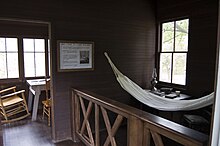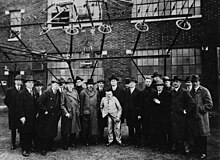Quick Facts

Biography
Charles Proteus Steinmetz (April 9, 1865 – October 26, 1923; birth-name: Karl August Rudolph Steinmetz) was a Prussian-born American mathematician and electrical engineer and professor at Union College. He fostered the development of alternating current that made possible the expansion of the electric power industry in the United States, formulating mathematical theories for engineers. He made ground-breaking discoveries in the understanding of hysteresis that enabled engineers to design better electromagnetic apparatus equipment including especially electric motors for use in industry.
Early life

Steinmetz was born Karl August Rudolph Steinmetz on April 9, 1865 in Breslau, Province of Silesia, the son of Caroline (Neubert) and Karl Heinrich Steinmetz. He was baptized a Lutheran, the religion his family "nominally" belonged to. Steinmetz suffered from dwarfism, hunchback, and hip dysplasia, as did his father and grandfather. Steinmetz attended Johannes Gymnasium and astonished his teachers with his proficiency in mathematics and physics.
Following the Gymnasium, Steinmetz went on to the University of Breslau to begin work on his undergraduate degree in 1883. He was on the verge of finishing his doctorate in 1888 when he came under investigation by the German police for activities on behalf of a socialist university group and articles he had written for a local socialist newspaper.
Socialism and technocracy
As socialist meetings and press had been banned in Germany, Steinmetz fled to Zürich in 1888 to escape possible arrest. Faced with an expiring visa, he emigrated to the United States in 1889. He changed his first name to "Charles" in order to sound more American, and chose the middle name "Proteus" after a childhood epithet given to him by classmates. Proteus was a wise hunchbacked character from the Odyssey who knew many secrets, and Steinmetz felt the name suited him.
Cornell University Professor Ronald R. Kline, the author of Steinmetz: Engineer and Socialist, contended that other factors were more directly involved in Steinmetz's decision to leave his homeland, such as the fact that he was in arrears with his tuition at the University of Breslau and that life at home with his father, stepmother, and their daughters was full of tension.
Despite his earlier efforts and interest in socialism, by 1922 Steinmetz concluded that socialism would never work in the United States, because the country lacked a "powerful, centralized government of competent men, remaining continuously in office", and because "only a small percentage of Americans accept this viewpoint today".
A member of the original Technical Alliance, which also included Thorstein Veblen and Leland Olds, Steinmetz had great faith in the ability of machines to eliminate human toil and create abundance for all. He put it this way: "Some day we make the good things of life for everybody".
Engineering

Steinmetz is known for his contribution in three major fields of alternating current (AC) systems theory: hysteresis, steady-state analysis, and transients.
AC hysteresis theory
Shortly after arriving in the United States, Steinmetz went to work for Rudolf Eickemeyer in Yonkers, New York, and published in the field of magnetic hysteresis, which gave him world-wide professional recognition. Eickemeyer's firm developed transformers for use in the transmission of electrical power among many other mechanical and electrical devices. In 1893 Eickemeyer's company, along with all of its patents and designs, was bought by the newly formed General Electric Company, where he quickly became known as the engineering wizard in GE's engineering community.
AC steady state circuit theory
Steinmetz's work revolutionized AC circuit theory and analysis, which had been carried out using complicated, time-consuming calculus-based methods. In the groundbreaking paper, "Complex Quantities and Their Use in Electrical Engineering", presented at a July 1893 meeting published in the American Institute of Electrical Engineers (AIEE), Steinmetz simplified these complicated methods to "a simple problem of algebra". He systematized the use of complex number phasor representation in electrical engineering education texts, whereby the lower-case letter "j" is used to designate the 90-degree rotation operator in AC system analysis. His seminal books and many other AIEE papers "taught a whole generation of engineers how to deal with AC phenomena".
AC transient theory
Steinmetz also made greater strides to the understanding of lightning phenomena. He undertook a systematic study of it, resulting in experiments with "man-made lightning" in the laboratory; this work was published. Steinmetz was called the "forger of thunderbolts", being the first to create artificial lightning in his football field-sized laboratory and high towers built at General Electric, using 120,000 volt generators. He erected a lightning tower to attract natural lightning, and studied the patterns and effects of lightning resulting in several theories and ideas.
Professional and personal aspects
Steinmetz became Professor of Electrical Engineering at Union College in 1902, as well as Chairman of the Electrical Engineering Department and served on the faculty until the end of World War I. He was awarded honorary degrees by both Harvard University and Union. Steinmetz also served as president of the Board of Education of Schenectady, New York, and as president of the Schenectady City Council. He was president of the American Institute of Electrical Engineers (AIEE) from 1901 to 1902, as well as the first vice-president of the International Association of Municipal Electricians (IAME) — which later became the International Municipal Signal Association (IMSA) — from 1913 until his death. Steinmetz wrote 13 books and 60 articles, not all about engineering. He was a member and adviser to the fraternity Phi Gamma Delta at Union College, whose chapter house there was one of the first electrified houses ever.
Steinmetz was a lifelong agnostic.
Legacy
Steinmetz died on October 26, 1923 and was buried in Vale Cemetery, Schenectady, New York.

Based on Steinmetz experiments, "Steinmetz's formula" defines the approximate heat energy due to magnetic hysteresis released, per cycle per unit area of magnetic material. Steinmetz equivalent circuit theory is still widely used for the design and testing of induction motors.
One of the highest technical awards given by the Institute of Electrical and Electronics Engineers, for major contributions to standardization within the field of electrical and electronics engineering, is named in his honor as the IEEE Charles Proteus Steinmetz Award.
His connection to Union College is celebrated with the annual Steinmetz Symposium, a day-long event in which Union undergraduates give presentations on research they have done. Steinmetz Hall, which houses the Union College computer center, is named after him.
Steinmetz was portrayed in 1959 by the actor Rod Steiger in the CBS television anthology series, The Joseph Cotten Show. The episode focused on his socialist activities in Germany.
A Chicago public high school, Steinmetz College Prep, is named for him.
A public park in north Schenectady, New York was named for him in 1931.
Patents
At the time of his death, Steinmetz held over 200 patents:
- U.S. Patent 533,244, "System of distribution by alternating current" (January 29, 1895)
- U.S. Patent 559,419, "Inductor dynamo"
- U.S. Patent 583,950, "Three phase induction meter"
- U.S. Patent 594,145, "Inductor dynamo"
- U.S. Patent 714,412, "Induction motor"
- U.S. Patent 717,464, "System of electrical distribution"
- U.S. Patent 865,617, "Induction motor"
- U.S. Patent 1,025,932, "Means for producing light" (May 7, 1912)
- U.S. Patent 1,042,986, "Induction furnace"
- U.S. Patent 1,230,615, "Protective device"
- U.S. Patent RE11,576, "Inductor dynamo"
- "C. P. Steinmetz". Becklaser.
In popular culture
Steinmetz is featured in John Dos Passos's U.S.A. trilogy in one of the biographies. He also serves as a major character in Starling Lawrence's The Lightning Keeper.
Novelist John Ball grew up in Steinmetz's house. His parents were graduate students paid by General Electric to live with and take care of the man Ball called "Uncle Steinie." Ball used to tell his Steinmetz stories to the Southern California Mystery Writers Association meetings.
Steinmetz is a major character in the novel Electric City by Elizabeth Rosner. In this epic story of technology, Rosner connects Steinmetz's early ethos as a socialist with his humanitarian vision of a better society based on technological progress: "The political arena that had summoned him in his youth, Socialist views that sent him into exile all those years earlier, further contributed to a seemingly endless hunger for change".
Awards
- Certificate of Merit of Franklin Institute (1908)
- Elliott Cresson Medal (1913)
- Cedergren Medal (1914)
Works
- The Second Law of Thermodynamics and the "Death" of Energy, with Notes on the Thermodynamics of the Atmosphere, General Electric Review, Volume 15, July, 1912, pages 419 - 424
- On the Law of Hysteresis, AIEE Trans., IX:3-64, 1892; Proc. of the IEEE, 72(2):197-221, doi: 10.1109/PROC.1984.12842
- Complex Quantities and Their Use in Electrical Engineering, AIEE Proceedings of International Electrical Congress, July 1893, pp. 33–74
- Theory of the General Alternating Current Transformer, AIEE Trans., XII:245-256, Jan. 1895
- Theory and Calculation of Alternating Current Phenomena, with the assistance of Ernst J. Berg, 1897. Information from this book has been reprinted in many subsequent engineering texts.
- The Alternating Current Induction Motor. AIEE Trans., XIV (1): 183-217, 1897.
- The Natural Period of a Transmission Line and the Frequency of Lightning Discharge Therefrom, The Electrical World, p. 203-205, August 27, 1898.
- Speed Regulation of Prime Movers and Parallel Operation of Alternators, AIEE Trans., XVIII:741-744, Jan. 1901.
- Theoretical Elements of Electrical Engineering, McGraw, 1902.
- The Alternating-Current Railway Motor, AIEE Trans., XXIII:9-25, Jan. 1904.
- Lightning Phenomena in Electric Circuits, AIEE Trans., XXVI(1):401-423, Jan. 1907.
- Electrical Engineering Education, AIEE Trans., XXVII(1):79-85, Jan. 1908.
- Future of Electricity, Transcript of lecture to the New York Electrical Trade School, 1908.
- Primary Standard of Light, AIEE Trans., XXVII(2):1319-1324, Jun. 8, 1908.
- The General Equations of the Electric Circuit, AIEE, Trans., XXVII(2):1231-1305, Jun. 8, 1908.
- General Lectures on Electrical Engineering, edited by Joseph Le Roy Hayden, Robson & Adee, 1908.
- Prime Movers, AIEE Trans., XXVIII(1):63-84, Jan. 1909.
- The Value of the Classics in Engineering Education, AIEE, Trans. XXVIII(2):1103-1106, Jun. 9, 1909.
- Radiation, Light and Illumination : A Series of Engineering Lectures Delivered at Union College, ed. by Joseph Le Roy Hayden, McGraw, 1909
- Disruptive Strength with Transient Voltages, with Hayden, Joseph L. R. principal author, AIEE Trans., XXIX(2):1125-1158, May 10, 1910.
- Engineering Mathematics; A Series of Lectures Delivered at Union College, McGraw, 1911.
- Mechanical Forces in Magnetic Fields, AIEE Trans., XXX(1):367-385, Jan. 1911.
- Elementary Lectures on Electric Discharges, Waves and Impulses, and Other Transients, McGraw, 1911.
- Theory and Calculation of Transient Electric Phenomena and Oscillations, McGraw, 1911.
- Some Problems of High-Voltage Transmissions, AIEE Trans., XXXI(1):167-173, Jan. 1912.
- Instability of Electric Circuits, AIEE Trans., XXXII(2):2005-2021, May 13, 1913.
- Recording Devices, AIEE Trans., XXXIII(1):283-292, Jan. 1914.
- Outline of Theory of Impulse Currents, AIEE Trans., XXXV(1):1-31, Jan. 1916.
- America and the New Epoch, Harper, c. 1916.
- Theory and Calculation of Electric Apparatus, McGraw, 1917.
- America's Energy Supply, AIEE Trans., XXXVII(2):985-1014,Jul. 18, 1918.
- The Oxide Film Lightning Arrester, AIEE Trans., XXXVII(2):871-880, Jul. 18, 1918.
- The General Equations of the Electric Circuit-III, AIEE Trans., XXXVIII(1):191-260, Jan. 1919.
- Power Control and Stability of Electric Generating Stations, AIEE Trans., XXXIX(2):1215-1287, Jul. 20, 1920.
- Condenser Discharges Through a General Gas Circuit, AIEE Trans., XLI:63-76, Jan. 1922.
- Essay on Science and Religion at Project Gutenberg. Homer Heath Nugent, 1922.
- High-Voltage Insulation, with Hayden, J. L. R. principal author, AIEE Trans., XLII:1029-1042, Jan. 1923.
- Frequency Conversion by Third Class Conductor and Mechanism of the Arcing Ground and Other Cumulative Surges, AIEE Trans., XLII:470-477, Jan. 1923.
- Four Lectures on Relativity and Space, McGraw, 1923.
- Cable Charge and Discharge, AIEE Trans., XLII:577-592, Jan. 1923 .
- Overdamped Condenser Oscillations, AIEE Trans., XLIII:126-130, Jan. 1924.
